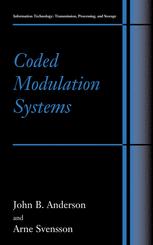

Most ebook files are in PDF format, so you can easily read them using various software such as Foxit Reader or directly on the Google Chrome browser.
Some ebook files are released by publishers in other formats such as .awz, .mobi, .epub, .fb2, etc. You may need to install specific software to read these formats on mobile/PC, such as Calibre.
Please read the tutorial at this link: https://ebookbell.com/faq
We offer FREE conversion to the popular formats you request; however, this may take some time. Therefore, right after payment, please email us, and we will try to provide the service as quickly as possible.
For some exceptional file formats or broken links (if any), please refrain from opening any disputes. Instead, email us first, and we will try to assist within a maximum of 6 hours.
EbookBell Team

4.4
102 reviewsCoded Modulation Systems is an introduction to the subject of coded modulation in digital communication. It is designed for classroom use and for anyone wanting to learn the ideas behind this modern kind of coding. Coded modulation is signal encoding that takes into account the nature of the channel over which it is used. Traditional error correcting codes work with bits and add redundant bits in order to correct transmission errors. In coded modulation, continuous time signals and their phases and amplitudes play the major role. The coding can be seen as a patterning of these quantities. The object is still to correct errors, but more fundamentally, it is to conserve signal energy and bandwidth at a given error performance. The book divides coded modulation into three major parts. Trellis coded modulation (TCM) schemes encode the points of QAM constellations; lattice coding and set-partition techniques play major roles here. Continuous-phase modulation (CPM) codes encode the signal phase, and create constant envelope RF signals. The partial-response signaling (PRS) field includes intersymbol interference problems, signals generated by real convolution, and signals created by lowpass filtering. In addition to these topics, the book covers coding techniques of several kinds for fading channels, spread spectrum and repeat-request systems. The history of the subject is fully traced back to the formative work of Shannon in 1949. Full explanation of the basics and complete homework problems make the book ideal for self-study or classroom use.